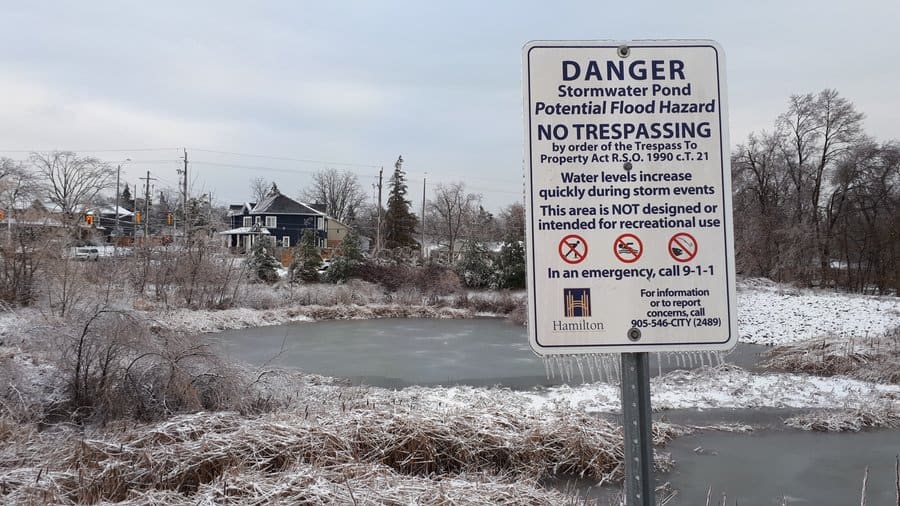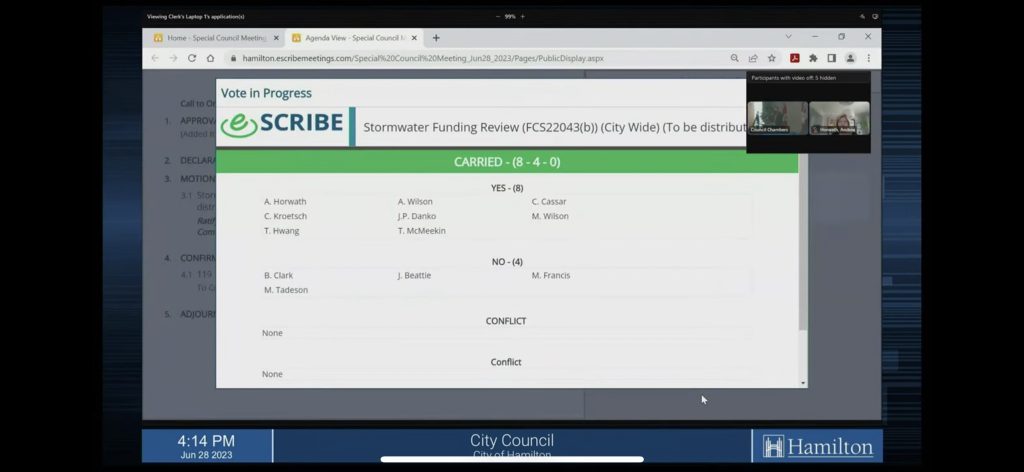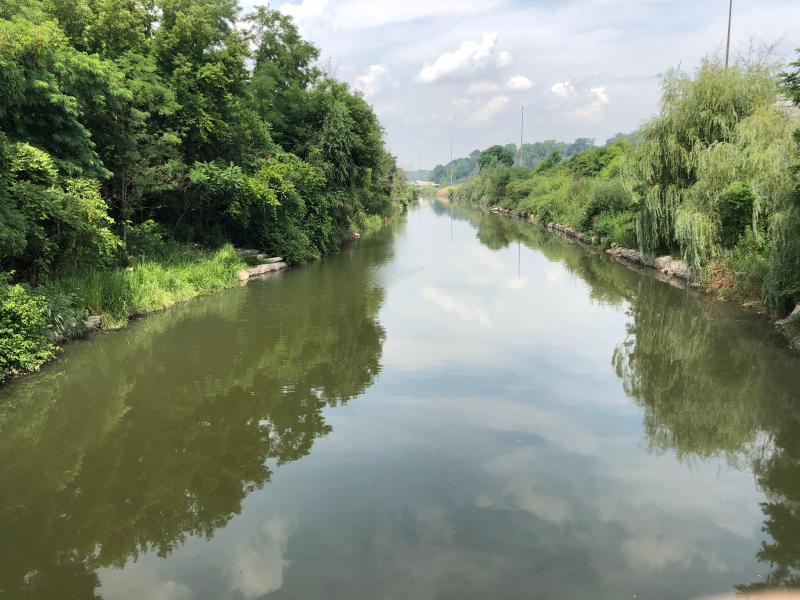Changes coming to stormwater fees, some Hamilton councillors oppose measure
Published July 12, 2023 at 11:50 am

In several years, most property owners in Hamilton will be paying for stormwater costs directly through a new “sustainable” and “equitable” user pay model.
But some councillors have pushed back against changing the method used to recover costs for stormwater management services, which would create a dedicated stormwater fee. They said rural property owners and the public should be widely consulted first.
Despite some councillors’ concerns, the majority of council voted for a new way to recover costs for stormwater management services in Hamilton. City council ratified the motion during a special General Issues Committee meeting on June 28.
The changes would take effect Sept. 1, 2025.
The ratified motion doesn’t yet involve creating new stormwater rates. The City plans by December to do public consultations and create a financial incentive program for property owners who reduce or improve the quality of stormwater runoff.

City council voted to ratify a new stormwater fee structure for Hamilton during a special meeting on June 28, 2023.
City has stormwater funding gap of $30 million
The funding from the dedicated stormwater fee aims to “strengthen the resiliency” of the stormwater system and “protect natural resources and waterbodies” from the harmful effects of stormwater. Problems from stormwater, which carries “harmful pollutants,” include flooding, erosion and poor water quality in waterbodies such as rivers, lakes, creeks and wetlands.
The City cited the need for “sustainable funding” and financial challenges including Hamilton’s annual stormwater funding gap of $30 million. It will cost an estimated $43 million alone to manage the stormwater system this year in Hamilton, funded by both the rate and general tax levy. For 2025, the City’s stormwater budget is $54 million.
The process to implement the new stormwater fee structure will cost $500,000 maximum and will be funded from the stormwater reserve.
The move creates a dedicated user fee for stormwater services, which will be separate in the utility bill. The stormwater fee revenue will fund “all aspects of the City’s stormwater services,” according to the report presented to council. Council will review the stormwater charge annually during each budget process.
A by-law will be drafted that will include provisions allowing for a review or appeal of proposed stormwater assessments if a property is assessed too high and if possible legal exemptions exist.
Changes mean average water bills would drop by about 12% in 2025: report
Removing stormwater management funding from the water and wastewater rate would reduce the water and wastewater rates, according to the report. So for the average residential consumer, their water bills in 2025 would decrease by about 12 per cent.
The dedicated fee would be “revenue neutral” rather than generating more revenue than what was identified in the 2025 budget, the report to council noted. Aecom Canada Ltd is the consultant that will help Hamilton implement the new stormwater rate structure. It recommends transferring $14 million to the climate reserve along with the introduction of stormwater rate structure.
This dedicated stormwater fee would apply to almost all developed properties within the city. This means several thousand properties currently not contributing to the program would have to start paying stormwater fees. They currently don’t pay for the fees since they are not connected to the City’s water and wastewater system. They include parking lots, storage facilities and rural properties without access to the municipal water or wastewater systems.

Between January 2014 and July 2018, 24 billion litres of raw sewage leaked into Chedoke Creek in Hamilton because of an open bypass gate. COURTESY CITY OF HAMILTON
Measure addresses underlying issues that led to Chedoke Creek disaster: Councillor Danko
Ward 8 Councillor John-Paul Danko was fully supportive of the new stormwater fee structure that council ratified.
“This term of council I think made a really courageous milestone decision on Jan. 25 when we committed unanimously to a stormwater management fee to be in place for 2025,” he said during the meeting. ”We made a commitment as council to address the stormwater infrastructure issues that we have in our city that were brought to a head by the Chedoke Creek incident. … It was front and centre one of the defining issues of every campaign that every one of us ran on that we were going to take action on Chedoke Creek and stormwater infrastructure.”
Danko argued that the new structure will address the underlying issues that led to the Chedoke Creek disaster.
“This is balancing who pays for what, not a new tax or fee,” he said. “This is good policy, it’s the right thing to do. It’s in line with our strategic priorities and it is fair and it addresses the issues that we as a city and council have committed to address.”
City to have ‘a more equitable stormwater funding model’: project manager
Nancy Hill, project manager and municipal infrastructure engineer at Aecom, highlighted at the meeting how the new system would be a better and more equitable way to pay for stormwater costs.
Under the current system, the City mainly funds the stormwater program through its water and wastewater utility revenues based on the amount of municipal potable water consumption, so places such as parking lots pay little or even nothing, Hill explained. It is also funded to a much lesser extent by property taxes including charges related to new development. But the change means the City will implement “a more equitable stormwater funding model.”
She pointed out that there’s no correlation between potable water consumption and a property’s impact on stormwater.
“The current system is inequitable,” Hill said. “We want better system that better reflects user pay.”
Since they don’t contribute to the stormwater system, properties still in their natural state would be excluded from the fee, including undeveloped properties, forested areas and parks with no infrastructure.
Hill explained that all rural properties contribute about $1.5 million towards stormwater management through property taxes. However, the City spent over $2.6 million on rural drainage projects plus $11.7 million on joint rural/urban initiatives in 2022.
Residential ratepayers (except multi-residential) are responsible for almost 50 per cent of water and wastewater revenues and residential taxpayers contribute 70 per cent of taxation revenues while they are responsible for about 43 per cent of the stormwater runoff, according to Hill.
“This means residential rate and taxpayers are indirectly subsidizing the cost of the stormwater system for other sectors under the current storm system funding,” Hill told council in a presentation. “So this is realigning it … So it is not changing the size of the pie, it’s changing how the pie is broken up.”

A large stormwater pond, also called “Bioswale,” is found at Gage Park in Hamilton. COURTESY CITY OF HAMILTON VIA TWITTER
Some councillors oppose lack of consultations
Ward 9 Councillor Brad Clark took issue with the lack of broader public consultation before ratifying the new stormwater fee structure. He seconded a motion by Ward 15 Councillor Ted McMeekin to defer the move until a broader consultation took place with farmers and other stakeholders. That deferral motion was defeated and the recommendation to change the stormwater rate structure was ratified.
“The report did not consult the public, rural farmers and Indigenous communities,” Clark said. “I have fundamental concerns about this process.”
Ward 10 Councillor Jeff Beattie said he had a problem with ramming through the motion without adequately consulting the $1.3-billion farm industry.
Hill said the rural and agricultural groups and the City did not find a date that worked before the ratification vote.
“I find it troubling that the stakeholders of a $1.3-billion industry and 80 per cent of landmass within the city of Hamilton weren’t properly consulted especially when the consultation could have happened as soon as tomorrow. I find that distressing,” he said.
Hill said a “concession” was made because rural properties have twice the impervious area (hard surfaces that contribute to polluted stormwater runoff) than urban properties, but the new rate structure would mean they would be charged the same as urban properties.
As for concerns about rural properties being charged although they are not part of the municipal water system, Hill said they do have some stormwater runoff that ends up in ditches and creeks. “The City does spends resources managing ditches and also managing natural creeks,” she told council. “So I think it is fair to say that rural properties do have an impact on the stormwater system that includes watercourses (and) ditches.”
Hill said most Ontario municipalities like Ottawa are already charging rural properties dedicated stormwater user fees. “Most properties do end up in the stormwater system whether natural or engineered,” she said.
New stormwater rate structure based on ‘guiding principles’
The new stormwater fee structure creates a “sustainable user-pay stormwater program.”
Aecom has recommended the “single family unit” stormwater fee structure out of seven stormwater fee models used in other Ontario municipalities because it “most closely aligns” with the guiding principles. These include fairness and equity, climate resilience and environmentally sustainable, and an affordable and financially sustainable system.
Under the new system, the stormwater charge would be based on the average amount of impervious area (or hard surface) for properties within that category. Impervious areas generally contribute a higher amount of stormwater runoff compared to soft surfaces, according to Hill. They include surfaces such as buildings, paved areas, driveways and walkways.
Aecom based the new system on impervious areas because the volume and rate of water that flows from property “is often correlated with the pickup of pollutants.” “It’s not perfect but it is certainly a lot closer to a user pay concept than potable water consumption or assessed value,” Hill said.
New model bases fees on ‘impervious’ area or hard surfaces that foster stormwater runoff
Size or location won’t matter so all single family detached dwellings would pay the same amount. Those in rural areas have an average impervious area that is more than double that of the residential impervious area within the urban boundary. However, they will still pay the same amount as other single family detached dwellings. The total residential impervious area represents 45 per cent of the total impervious area so it will contribute 45 per cent of the total stormwater funding revenue. All other properties, such as industrial and commercial properties, would contribute the remaining 55 per cent.
Hill presented estimated rates for illustrative purposes to give council an idea what it may charge under the single family unit model.
For instance, all single family dwellings, regardless of the amount of water they use, would be charged $170 in their annual storm bill.
Multi-family residential properties, such as townhouses, would be charged less than single family detached homes since they have a smaller footprint than them.
Industrial, commercial and institutional, mixed use properties and high-rise residential buildings will be charged based on their impervious surfaces, measured using recent aerial imagery, which contribute to runoff. Undeveloped land would be excluded from a stormwater fee.
What is stormwater and its impact in Hamilton?
Stormwater comes from rain and melted snow, flowing over land and into storm drains, ditches, creeks and lakes. Impervious or hard surfaces, such as asphalt, concrete and rooftops, prevent stormwater from slowly naturally soaking into the ground to replenish creeks, lakes, wetlands and aquifers, according to the report presented to council. Instead, they create runoff that gush into storm drains and sewer systems and then to creeks and lakes, carrying more pollutants, such as oil, grit, nutrients and litter into creeks and lakes.
The report noted many pressures on the City’s stormwater system, including aging infrastructure, urbanization and climate change’s growing impacts.
“Without proper financing and preventative maintenance, there is potential for disruptive failures and costly repairs,” it said.
‘Work needs to be done to right that wrong’: Wilson
“We are one city, we have one impact,” said Ward 1 Councillor Maureen Wilson who supported the measure. She noted during the meeting that “$24 billion of sewage entered Chedoke over four years. Work needs to be done to right that wrong.”
“I find part of debate a little bit of depressing that we are going to parse streams according to a rural or urban boundary,” she explained. “We are one city, we have one impact. And this has been identified as this council’s strategic priority. In the absence of funding it, we’re not going to be able to achieve that priority. And that undermines trust and confidence.”
Ward 2 Councillor Cameron Kroetsch said council has to act now to get the new dedicated stormwater fee implemented in 2025. “We have to keep moving this forward. We are way behind and I mean decades and decades behind our progress in this issue,” he told council. “We’re going to spread the impact out so everyone in the whole city of Hamilton is paying into the system whether structurally engineered or naturally managed. There is no disconnected water system.”
Councillor Danko said Hamilton is one of last municipalities to implement a citywide stormwater management fee.
“(We’re) doing this for clean water, stable and equitable funding source for stormwater management system (that is) $30 million underfunded every year,” he said. “It’s a benefit for the city as a whole and it doesn’t matter where you live. We all benefit from clean water. The Chedoke disaster should highlight that.”
Mayor Andrea Horwath also backed the new stormwater funding model, saying it’s “a path forward that makes sense.”
“I appreciate that it is hard,” Mayor Andrea Horwath said. “Leadership isn’t easy. … We do have a commitment to further some engagement if this structure is able to be enshrined. There are other pieces that are still to come. Really, we have to make decisions and we can’t just keep kicking things down the road. We have three and half years left. We have some pretty ambitious goals. We will not achieve it if we don’t have courage.”
insauga's Editorial Standards and Policies advertising






